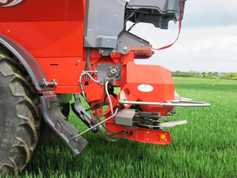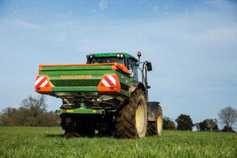Teagasc fertiliser advice is reviewed is on an ongoing basis in light of new national and international research findings, changes in farm practices, nutrient regulations and the onset of new grass and crop varieties with different nutrient requirements.
Prior to now, the latest nutrient advice for grassland and tillage crops was available in the third edition of the Teagasc Green Book (Coulter and Lalor, 2008).
In 2016, a full revision and update of nutrient advice was conducted incorporating the latest scientific research and knowledge to produce the present volume (fourth edition) published by Wall and Plunkett (2016).
Some of these updates in the new Green Book are summarised as follows.
What’s new
Soil types and nutrient cycling – information on the major soil types in Ireland and their influence on nutrient cycling and management, including links to further information of Irish soils.Fertiliser ingredients – definitions and information on the main fertiliser ingredients available in Ireland.Adaptive nutrient management planning (NMP) online – information on the new nutrient management system NMP online and how it can be used to facilitate better nutrient management planning and sustainable outcomes for farmers into the future. Nutrients for energy crops – new information and nutrient recommendations for energy crop production.Revised sections
Soil acidity and liming – improved information on importance of soil pH correction and new information on lime and lime products has been included. Nutrients in organic manures – updated the fertiliser replacement values for slurries and provide new information on nutrient constituents in a range of organic manure and biosolid types. Information on tools to measure slurry variability and how to maximise slurry efficiency.Grassland – new nitrogen (N) advice for beef and sheep systems and suggested application timings for fertilisers.Cereals – new advice on N application timings for cereal crops.Potatoes – new N advice for potatoes, which considers production system and haulm longevity.Oilseed rape – new advice on N timing based on density of the crop and leaf area index.Vegetable crops – update of N, phosphorus (P) and potassium (K) advice for vegetable crops based on best available information has been included.Fertiliser advice from Johnstown Castle has always been based on a combination of agronomic and economic factors. In recent decades, environmental sustainability has been given increased prominence and is advocated by adherence to codes of good agricultural practice, by taking account of nutrients in organic manures and by applying no more nutrients than were necessary to achieve optimum yields of crops.
As more scientific studies are conducted with the aim of increasing the technical and environmental efficiency of Irish farm production systems, new advice must be developed and effectively disseminated to achieve practice adoption by advisers and farmers. The new Green Book of nutrient advice is an example of this process and aims to provide the agricultural industry with the latest knowledge to manage our most important resource “our soils” for the future.
The new Green Book is available as a free download at: https://www.teagasc.ie/media/website/publications/2016/soil-fertility-green.pdf.
To receive a printed copy, please contact Ms Sarah Lacey, Teagasc, Johnstown Castle, 053-9171200 or email: sarah.lacey@teagasc.ie.
Teagasc fertiliser advice is reviewed is on an ongoing basis in light of new national and international research findings, changes in farm practices, nutrient regulations and the onset of new grass and crop varieties with different nutrient requirements.
Prior to now, the latest nutrient advice for grassland and tillage crops was available in the third edition of the Teagasc Green Book (Coulter and Lalor, 2008).
In 2016, a full revision and update of nutrient advice was conducted incorporating the latest scientific research and knowledge to produce the present volume (fourth edition) published by Wall and Plunkett (2016).
Some of these updates in the new Green Book are summarised as follows.
What’s new
Soil types and nutrient cycling – information on the major soil types in Ireland and their influence on nutrient cycling and management, including links to further information of Irish soils.Fertiliser ingredients – definitions and information on the main fertiliser ingredients available in Ireland.Adaptive nutrient management planning (NMP) online – information on the new nutrient management system NMP online and how it can be used to facilitate better nutrient management planning and sustainable outcomes for farmers into the future. Nutrients for energy crops – new information and nutrient recommendations for energy crop production.Revised sections
Soil acidity and liming – improved information on importance of soil pH correction and new information on lime and lime products has been included. Nutrients in organic manures – updated the fertiliser replacement values for slurries and provide new information on nutrient constituents in a range of organic manure and biosolid types. Information on tools to measure slurry variability and how to maximise slurry efficiency.Grassland – new nitrogen (N) advice for beef and sheep systems and suggested application timings for fertilisers.Cereals – new advice on N application timings for cereal crops.Potatoes – new N advice for potatoes, which considers production system and haulm longevity.Oilseed rape – new advice on N timing based on density of the crop and leaf area index.Vegetable crops – update of N, phosphorus (P) and potassium (K) advice for vegetable crops based on best available information has been included.Fertiliser advice from Johnstown Castle has always been based on a combination of agronomic and economic factors. In recent decades, environmental sustainability has been given increased prominence and is advocated by adherence to codes of good agricultural practice, by taking account of nutrients in organic manures and by applying no more nutrients than were necessary to achieve optimum yields of crops.
As more scientific studies are conducted with the aim of increasing the technical and environmental efficiency of Irish farm production systems, new advice must be developed and effectively disseminated to achieve practice adoption by advisers and farmers. The new Green Book of nutrient advice is an example of this process and aims to provide the agricultural industry with the latest knowledge to manage our most important resource “our soils” for the future.
The new Green Book is available as a free download at: https://www.teagasc.ie/media/website/publications/2016/soil-fertility-green.pdf.
To receive a printed copy, please contact Ms Sarah Lacey, Teagasc, Johnstown Castle, 053-9171200 or email: sarah.lacey@teagasc.ie.






 This is a subscriber-only article
This is a subscriber-only article











SHARING OPTIONS: